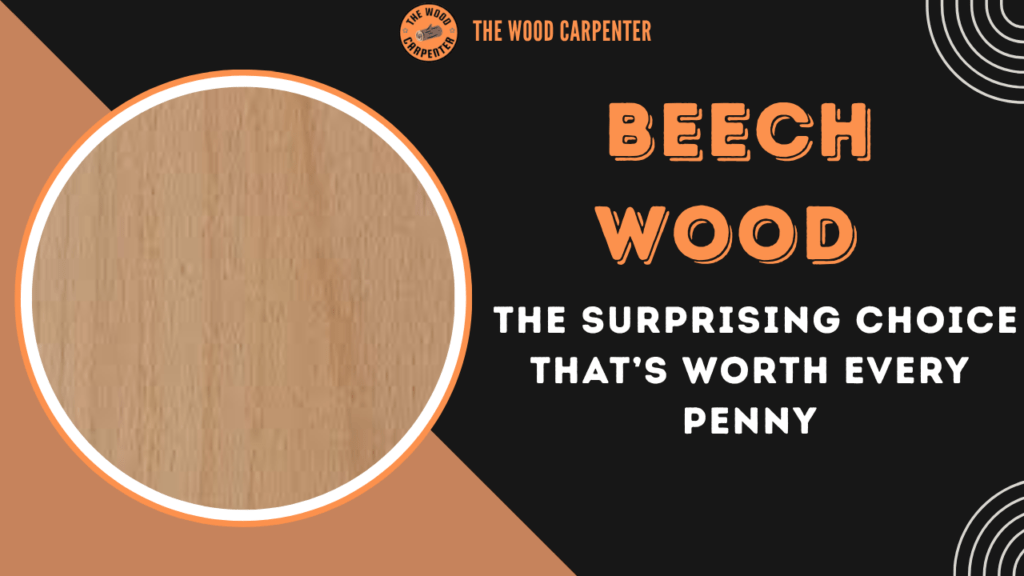
Beech wood is one of the most popular and useful hardwoods in the world. People like it because it is strong, looks nice, and is easy to work with. It is commonly used in furniture, carpentry, and many everyday wooden items. This article explains the basics of beech wood—what it is, what it looks like, how it’s used, and more.
What is Beech Wood?
Beech wood comes from trees in the Fagus family. The two main types are:
European beech (Fagus sylvatica) – It is found mostly in Central and Southern Europe
American beech (Fagus grandifolia) – Grows in Eastern United States
Both types are strong and have a fine, smooth grain, which makes them very useful.
Appearance and Physical Properties
Color: Beech wood is mostly in pale cream or light pink-brown. After steaming, it can turn golden or reddish.
Grain: The grain is straight and even, giving it a clean and smooth appearance.
Texture: It has a fine and smooth surface, which is great for painting or finishing.
Weight: Beech is a fairly heavy wood, weighing around 680–720 kg per cubic meter when dry.
Hardness: It is quite hard—similar to oak—so it handles wear and tear well.
Ease of Use (Workability)
Beech wood is easy to cut, sand, shape, and bend using both hand tools and machines. That’s why woodworkers like it so much. It also bends well with steam, which is useful in making curved furniture parts.
Durability
While beech is strong and tough, it does not naturally resist moisture, bugs, or rot. This means it’s not good for outdoor use unless it’s treated or sealed properly.
Key Uses of Beech Wood
1. Furniture
Beech wood is perfect for making furniture. It’s strong, has a smooth and even grain, and is easy to shape. That’s why it’s used in both old-style and modern furniture.
Strong and Stable: Great for furniture that needs to support weight, like chairs, beds, and tables.
Flexible Designs: Easy to bend and shape, so it works well for curved furniture like bentwood chairs.
Good Value: Looks expensive but costs less than woods like walnut or cherry. Its light color can also be stained to match other woods.
2. Flooring
Beech is also used for wooden floors.
Smooth Look: Its even color and grain make rooms look clean and neat.
Durable: Handles lots of walking and foot traffic—good for kitchens, halls, and living rooms.
Affordable Beauty: Looks great like expensive hardwoods but at a lower price.
3. Kitchen Items
Beech wood is safe for food when treated, and it doesn’t splinter easily. That’s why it’s often used for:
- Cutting boards
- Cooking utensils
- Butcher blocks
4. Toys and Small Wooden Items
Because it has a fine, smooth texture and is easy to shape, beech wood is used for:
- Wooden toys
- Turned parts (like handles or knobs)
- Decorative items
5. Industrial Uses
Beech is strong and tough, so it’s also used in:
- Tool handles
- Sports gear
- Wooden crates and pallets
6. Firewood
Beech burns well and gives off good heat. It’s easy to split, burns for a long time, and gives a steady flame—great for fireplaces and stoves.
Also read:
Beech wood vs Teak wood: Which Wood Wins ?
Beech Wood vs. Other Hardwood Varieties
Here’s how beech wood compares to the most common hardwoods:
| Feature | Beech Wood | Oak | Maple | Walnut |
| Color | Pale cream, red-brown | From light to dark brown | Very light, uniform | Chocolate to purplish-brown |
| Texture/Grain | Fine, even, straight | Open grain, prominent | Closed grain, fine | Moderate, straight to curly |
| Hardness (Janka) | 1,450lbf (Europe); 1,300lbf (US) | 1,290–1,360lbf | 1,450lbf | 1,010lbf |
| Workability | Very good | Good, splits easily | Good, can burn tools | Excellent, but softer than beech |
| Steam Bending | Excellent | Good | Good | Fair |
| Durability Outdoors | Low | High (white oak) | Moderate | High |
| Common Uses | Furniture, flooring, kitchenware | Flooring, furniture, barrels | Furniture, flooring, sports gear | Luxury furniture, veneers |
| Price | Moderate | Moderate | Moderate | High |
Summary:
Beech vs. Oak: Both are strong and used for similar projects, but oak may offer better durability outdoors.
Beech vs. Maple: Maple is slightly harder and lighter in color, but both are excellent for furniture and flooring.
Beech vs. Walnut: Walnut excels in appearance for high-end furniture, but is softer and more costly.
Frequently Asked Questions (FAQs) About Beech Wood
Q1: What’s the difference between European and American beech?
A: European beech is lighter in color and has a finer grain, which makes it great for detailed work and smooth finishes. American beech is a bit darker with more grain variation. Both are strong, but European beech is more popular for high-quality furniture.
Q2: Can I use beech wood outdoors?
A: Not without special treatment. Beech doesn’t naturally resist water, bugs, or rot, so it’s best used indoors unless it’s properly sealed or treated.
Q3: How does beech compare to other hardwoods like oak or maple?
A: Beech is about as strong and hard as oak and maple, but often costs less. It has a smoother grain and bends better with steam. However, it’s not as weather-resistant as woods like teak or cedar.
Q4: Why is beech good for toys and kitchen tools?
A: Beech is smooth, safe for food, and has no strong smell or taste. It’s gentle on hands and mouths, and it holds up well with regular use.
Q5: What are the downsides of beech wood?
A: It’s not very resistant to weather, insects, or moisture. If not dried or cared for properly, it can warp or change shape over time.
Q6: Is beech wood environmentally friendly?
A: Yes—especially when it comes from certified, well-managed forests. European beech is widely grown and harvested using eco-friendly methods.
Q7: Can beech wood be stained or colored easily?
A: Yes! Its fine and even texture makes it great for staining or painting. You can make it look like more expensive woods or match your home décor easily.
Final Thoughts
Beech wood is strong, beautiful, easy to work with, and budget-friendly. It’s perfect for indoor furniture, floors, kitchen tools, and toys. The only things to watch out for are its sensitivity to moisture and lack of outdoor durability—but these can be managed with proper care.
If you’re looking for a hardwood that’s versatile, long-lasting, and eco-friendly, beech wood is a great choice.

